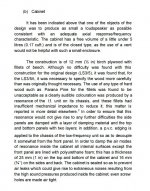Decouple mids and tweets. Use force cancellation on subs. CLD enclosures with ample strong bracing along the longest dimension, typically height. Mass dampening works best for >200Hz, so a heavy baffle is required.
HDF is quite good, nasty to work with and hard on router bits tho. Perhaps laminating multiple layers with epoxy... $$. Doing it right with a vacuum press $$$ 😉
HDF is quite good, nasty to work with and hard on router bits tho. Perhaps laminating multiple layers with epoxy... $$. Doing it right with a vacuum press $$$ 😉
I can't think of a worse thing to do, vibrations will simply be transmitted to the cabinet in a way no damping can deaden, it needs to be decoupled not coupled.
Instead you want all the excess driver energy pumped into the baffle… or stay in the driver?
We do this in almost all our builds and it works really well (almost all FRs). Driver energy is spread across more box faces which keeps energy levels low enuff that a panel resonance is much less likely to get excited, those extra panels are facing away so have less effect if they do get excited, and fixed part of the driver now coupled to the box has much greater mass so moves less increasing the DDR.
dave
Bingo !
Works for me ! Thanks for your post !
Decouple mids and tweets. Use force cancellation on subs. CLD enclosures with ample strong bracing along the longest dimension, typically height. Mass dampening works best for >200Hz, so a heavy baffle is required.
HDF is quite good, nasty to work with and hard on router bits tho. Perhaps laminating multiple layers with epoxy... $$. Doing it right with a vacuum press $$$ 😉
Works for me ! Thanks for your post !
Instead you want all the excess driver energy pumped into the baffle… or stay in the driver?
We do this in almost all our builds and it works really well (almost all FRs). Driver energy is spread across more box faces which keeps energy levels low enuff that a panel resonance is much less likely to get excited, those extra panels are facing away so have less effect if they do get excited, and fixed part of the driver now coupled to the box has much greater mass so moves less increasing the DDR.
dave
I was actually thinking about how things work in general rather than sound engineering, ie, something that is going to be subject to vibration has to be allowed a degree of movement. If it is mounted too rigidly internal failure is the result. Just a basic principle, whether it applies here or what the effect is on sound I don't know.
Having said that given a speaker is designed to "vibrate" I guess the engineering isn't an issue?
I think the amount of vibration that would cause fatigue is orders of magnitude higher than what we see in speakers. What we're trying to reduce is the amount of contribution to the sound field you hear by the cabinet. Experiments have shown that cabinet resonances are typically very sharp, and so take a "long" time to decay, changing the sound quality you can hear. Reducing these vibrations is a goal for many designers.
Used to think so too. But I'm not convinced any more. KEF in their LS50 decouple bracing from cabinet walls with some kind of damping material in order to reach specific transmission patterns. Apparently this gives better results than stiff joints, as resonances tend to be lower. One should be able to confirm this with FEM-analysis and/or panel motion measurements, but I've not yet been into that....but, bracing should be as stiff as possible and MDF is anything but. It would be better to just use BB ply throughout. A well braced box made from BB will have panel resonance high enough not to be an issue. Coupling the driver to the back of the enclosure with a dowel or as part of the bracing will negate the vibrations from the driver basket, big "bang for the buck".
KEF LS50, damped bracing, p. 18, Fig. 21
Decoupling and damping are slightly different.
Bracing - green, Damping material - red
http://www.kefamerica.com/july12/LS50 White Paper.pdf
Decoupling and damping are slightly different.
Bracing - green, Damping material - red
http://www.kefamerica.com/july12/LS50 White Paper.pdf
Last edited:
Of the commonly available "wood" sheet materials, the best is probably stranded bamboo plywood. Much more expensive than good ply.
Does anyone know of another source for multi-ply bamboo plywood (5 or 7 plies rather than 3)?
https://www.inventables.com/technologies/bamboo-plywood
The listed sheet size (12 x 24 inches max) and prices would seem to limit usage to fairly compact loudspeaker cabinets.
Dave, alternatively do you have a source for the material that you prefer?
kind regards, jonathan
Show us the end result (OP)!
Here some notes from BBC, BBC White Paper (RD1976-29) Cabinet
http://downloads.bbc.co.uk/rd/pubs/reports/1976-29.pdf
and more (nothing like old school🙂). The properties of materials, BBC White Paper (RD1977-03) - Factors in the design of loudspeaker cabinets
http://downloads.bbc.co.uk/rd/pubs/reports/1977-03.pdf
links:
http://www.loudspeakerbuilding.com/Practical-guide/Cabinet-materials/10101,en
http://www.woodweb.com/knowledge_base/Speaker_Box_Material__Solid_Wood_or_MDF.html
http://www.forestryforum.com/board/index.php?topic=58551.0
Here some notes from BBC, BBC White Paper (RD1976-29) Cabinet
http://downloads.bbc.co.uk/rd/pubs/reports/1976-29.pdf
and more (nothing like old school🙂). The properties of materials, BBC White Paper (RD1977-03) - Factors in the design of loudspeaker cabinets
http://downloads.bbc.co.uk/rd/pubs/reports/1977-03.pdf
links:
http://www.loudspeakerbuilding.com/Practical-guide/Cabinet-materials/10101,en
http://www.woodweb.com/knowledge_base/Speaker_Box_Material__Solid_Wood_or_MDF.html
http://www.forestryforum.com/board/index.php?topic=58551.0
Attachments
- Status
- Not open for further replies.
- Home
- Loudspeakers
- Multi-Way
- Speaker Construction Materials
